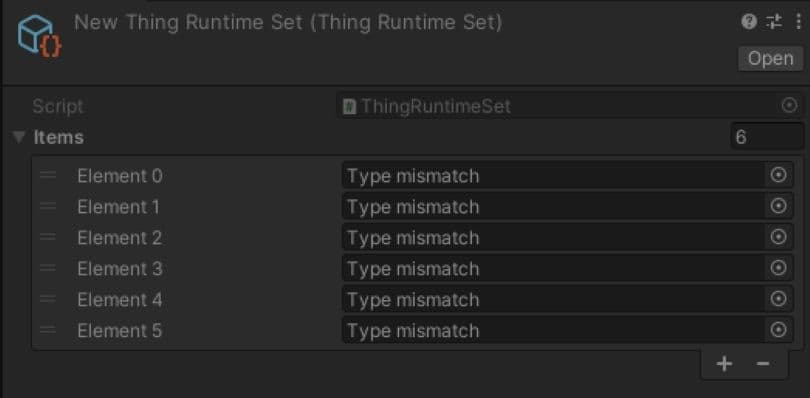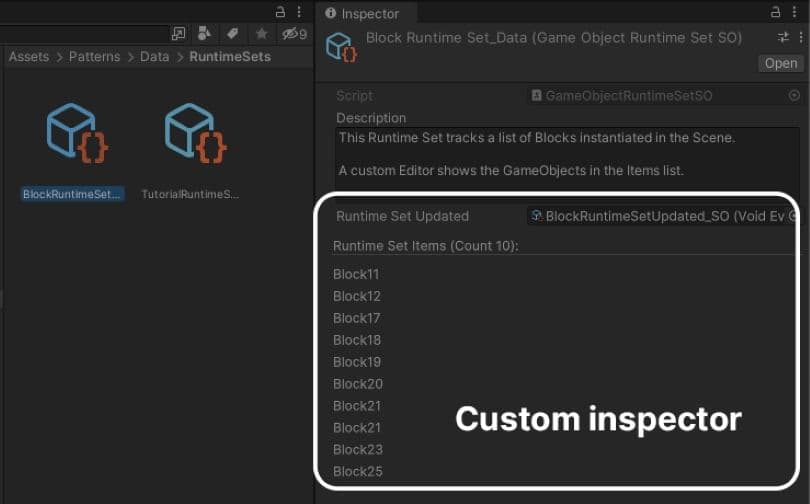
Before you dive into the ScriptableObject demo project and this series of mini-guides, remember that, at their core, design patterns are just ideas. They won’t apply to every situation. These techniques can help you learn new ways to work with Unity and ScriptableObjects.
Each pattern has pros and cons. Choose only the ones that meaningfully benefit your specific project. Do your designers rely heavily on the Unity Editor? A ScriptableObject-based pattern could be a good choice to help them collaborate with your developers.
Ultimately, the best code architecture is the one that fits your project and team.
ScriptableObjects can store static data. They can be modified to hold dynamic data as well. This is particularly useful for referencing a collection of GameObjects or components at runtime.
A “runtime set” like this replicates why some developers use singletons – easy global access. Unfortunately, singletons come with baggage like undesirable dependencies. These extra dependencies can complicate testing and make debugging more difficult.
As an alternative, consider using a ScriptableObject-based runtime set for frequently referenced components. For example, use them to track game elements like spawned enemies, collectibles, or checkpoints.
As project-level assets, ScriptableObjects provide global access to data for all objects within a scene. This feature allows for information sharing without many of the drawbacks associated with singletons.
Here’s one way to make a runtime set for GameObjects. Think of it like a data container that keeps a public collection of elements – but also includes methods to add and remove members.
At runtime, any MonoBehaviour can reference the public Items property to obtain the full list of GameObjects. Another script or component can call Add or Remove to modify the Items list.
You can make a runtime set more specific so that it only tracks a particular type of MonoBehaviour. In that case, create specific sets for each type (e.g., EnemyRuntimeSet, PickupRuntimeSet, etc.).
A generic abstract class can streamline this process. You could then derive other runtime sets from this base class. For example, if you wanted to make a runtime set for a custom Enemy component, you could define classes for a generic RuntimeSetSO<T> and concrete EnemyRuntimeSetSO like the code snippet below.
Notice that the concrete class, EnemyRuntimeSetSO, doesn’t have any implementation details, only a CreateAssetMenu attribute.
Each new component you want to track just needs a corresponding runtime set to manage it. Build as many concrete classes as you need. Enemies, NPCs, inventory items, quests, and more can all have their own runtime sets.

Managing the runtime set is up to you. Often, you can use a second MonoBehaviour to set up or update it during gameplay.
If you want a component to include itself in a set automatically, you can also invoke the runtime set’s Add or Remove methods from the MonoBehaviour’s OnEnable and OnDisable.
For example, your fictitious Enemy class might look like the code snippet below.
Here, each Enemy component can add or remove itself using its OnEnable or OnDisable methods. If the m_RuntimeSet field is set in the Inspector, the Enemy component will appear in the EnemyRuntimeSetSO automatically. This is especially handy if you’re using the Enemy component with Prefabs.
One limitation of this technique is that if you inspect the ScriptableObject at runtime, you won’t be able to see the contents of the Items list in the Inspector by default.
Instead, a “Type mismatch” appears in each element field. By design, a ScriptableObject can’t serialize a scene object. The list is actually working, but the data does not display correctly.
Use a public property or the HideInInspector attribute if you want to avoid confusion and prevent the list from showing in the Inspector.
You can also fix this issue with a custom Editor script and Inspector. Good examples include Soap – ScriptableObject Architecture Pattern in the Unity Asset Store or the Patterns demo example below.

Although PaddleBallSO doesn’t feature a use case for runtime sets, the project’s Patterns demo includes a small sample that shows this design pattern at work.
Click the Spawn Block button to fill in the wall of blocks incrementally. The ball destroys a block on contact.
Choose Select Set to show the BlockRuntimeSet_Data in the Inspector. This contains the list of all the blocks in the scene.
You can continuously fill blocks into the grid as quickly as the ball removes them. At the same time, the runtime set tracks the actively changing number of blocks in the Items list.
The Patterns demo shows a few quality-of-life enhancements when working with runtime sets:

The next time you need a centralized list of GameObjects or components, consider runtime sets. They can be less expensive than a find operation (Object.FindObjectOfType or GameObject.FindWithTag) and less problematic than singletons.
As ScriptableObjects, they are decoupled from individual GameObjects in the scene. Keep as many runtime sets as needed for anything you want to track frequently at runtime.
Runtime sets can simplify how you monitor gameplay objects without incurring unnecessary dependencies. You can spend the time saved during debugging and testing to develop new gameplay experiences for your players.

We hope that runtime sets can benefit your upcoming projects.
Read more about design patterns with ScriptableObjects in our technical e-book, Create modular game architecture in Unity with ScriptableObjects. You can also find out more about common Unity development design patterns in Level up your code with game programming patterns.